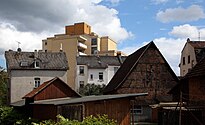Working-class district
Among working-class neighborhood (Engl. Working class quarter ) refers to a neighborhood, often in the vicinity of factories or larger stations, live in the mainly working-class families. In working-class neighborhoods there are mainly low-standard apartments with socially disadvantaged people. Especially in the past it was mostly poor, run-down areas. Due to far-reaching economic and social changes in the western world, there are fewer and fewer working-class quarters in the literal sense. After many of these quarters, especially in Germany, have recently been upgraded through renovations , today we tend to speak of old building areas or, in relation to the times , of Wilhelminian style quarters . Working-class quarters are not to be confused with working-class settlements that were built on the initiative of non-profit organizations or by entrepreneurs according to plan and partly in one go on the green field.
history
In the 19th century, working-class quarters often developed on areas of villages or manors that were closest to the larger historical cities and also close to the newly built railway lines, where industry was also established. That is why working-class quarters often have the names of former, independent places or, for example, in Nuremberg the final syllable ... hof . The historic town centers sometimes still exist today as rural islands, as has happened several times in Frankfurt am Main , for example in Unterliederbach .
From the middle of the 19th century, the creation of workers' housing became a key issue. In the early stages of the Industrial Revolution , workers' living conditions did not meet hygienic requirements. In addition, very few were able to finance a suitable apartment, which means that in many places they lived in a very confined space in sometimes overcrowded tenements , which became a symbol of the working-class district. Attempts were made to master these problems through solidarity -based self-help , company-owned workers' settlements and housing associations .
In the western world, many of these quarters have experienced an almost complete population exchange ( segregation ) since the 1960s due to deindustrialization , emigration and demographic decline in population with simultaneous influx of migrants into the vacant apartments . In the USA, enormous deindustrialization, especially in the rust belt , caused many working-class neighborhoods to deteriorate completely or even to have been recaptured by nature.
politics

In the 19th century, working-class neighborhoods were often the nucleus of the labor movement . The rise of the SPD began in 1877 via the Berlin constituency VI, which also included the workers' district of Wedding . The large Parisian working-class suburb of St. Denis became one of the first strongholds of the French labor movement and the French Communist Party (PCF) , which is still the mayor today.
Current situation
Today the state facilitates housing for low-income families through social housing and the allocation of housing benefits . This task is carried out by the respective municipality.
Apartments are scarce in many major German cities. In many places, the demand exceeds the supply. That is why the (former) working-class neighborhoods, which are mostly close to the city center, are becoming increasingly interesting and are often being redeveloped and upgraded. Some of these neighborhoods are experiencing a further appreciation, as a result of gentrification , with sharply rising rents and displacement of the original population.
Examples of working-class neighborhoods
Well-known, large working-class neighborhoods or suburbs are Berlin's Wedding or the Parisian suburb of St. Denis . Other German examples are Ostheim in Stuttgart, Oberhausen in Augsburg, Südstadt and Gibitzenhof in Nuremberg, the Bergl in Schweinfurt or the Zellerau in Würzburg.
- Working-class district
Plan of Berlin-Wedding, Ackerstrasse
area , left Meyers Hof 1910Dimitroffstrasse
in Chemnitz
post-war periodWorking-class neighborhood in Headingley
near Leeds
2006
Web links
- Design of the working-class district - courtyards and back alleys from: Friedrich Engels: The situation of the working class in England , 1845. online at www.textlog.de
swell
- Brockhaus Encyclopedia, Volume Two, FA Brockhaus-Verlag Mannheim, 19th edition, 1987, ISBN 3-7653-1100-6








